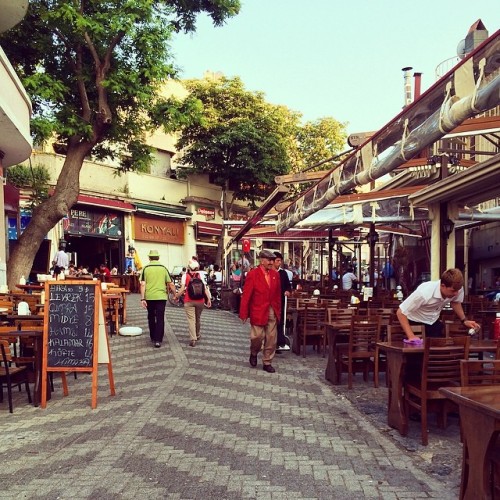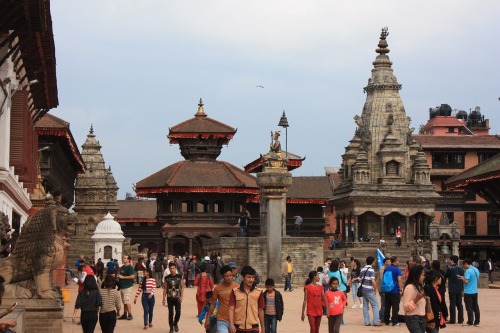Stop. talking. about Copenhagen.
If you are a transportation planner, engineer, or advocate in Portland who likes biking, walking, and/or public transport, you probably have a crush on Amsterdam and Copenhagen. It’s okay to admit it. You have probably been to one of those two cities. More than likely, you have featured one or both cities in at least one Powerpoint presentation tailored to other planners and engineers, who have likewise been to one or both places (I can hear you chuckling quietly!). Traveling to northern Europe for the express purpose of ogling their on-road facilities and bike-borne fashion has achieved pilgrimage status for transportation professionals in Portland and beyond.
I understand. The infrastructure is gorgeous. The pictures are amazing. Now please stop talking about them. Why? Because the vision of the future of our transportation system needn’t derive from northern Europe, any more than many of our city’s residents do. We can get past this fixation, and we can do it together! Change is possible. There is a wide world of great facilities out there, and they are ready and quite capable of inspiring. I didn’t even know about some of these gems before drafting this post.
For example (in order primarily of friends’ responses to my Facebook-borne question):
China
Nanjing Road in Shanghai is the world’s longest shopping district (5.5km), attracts one million visitors daily, and is an almost entirely pedestrian corridor. That is a higher annual visitor attendance to Nanjing Lu than to all the Walt Disney parks and resorts combined. NBD.

Wangfujing in Beijing is likewise a tremendously bustling and almost entirely pedestrianized street that has been a vital facility since the Ming Dynasty.
Turkey
Büyükada, one of Istanbul’s Princes Islands, is entirely carfree. Check this out:

İstiklal (”Independence”) Avenue, also in Istanbul, attracts about three million visitors a day on weekends. It is an entirely pedestrian street except for a trolley.

(For bonus transportation geekery points, you can check out the nearby Kabataş-Taksim Funicular)
Eskişehir has not one but seven tram routes connecting walkable neighborhoods in a beautiful city. Wouldn’t some of these pictures look gorgeous in a planning Powerpoint?
Brazil
Curitiba is beloved as a cycling and transportation city in a gushing, fanclub sort of way. Just ask Bill McKibben. In response to incredible population growth between 1960 and 1980—from 120,000 to 361,000 residents—city planners, as well as a feisty Mayor Jaime Lerner, opted to eschew traditional road-widening schemes in favor of comprehensive bus rapid transit (BRT). Curitiba’s BRT system provided a model for the soon-to-be scaled up version in …
Colombia
Bogotá. Should we highlight their bus rapid transit, or their weekly ciclovía—an opening of a network of streets to all modes except cars—developed in 1974? The answer is yes, and more.
Also, watch out for up-and-coming Medellín.
Japan
When asked where in Japan is great to bicycle, friends have responded with, “basically the entire country.” This was news to me, much to my shame. Yet, according to this recent PSU presentation, Japan has an estimated 80,000,000 bicycles, which are used to navigate its cities’ narrow streets and dense neighborhoods.
Or how about the 60km Shimanami Kaido, stretching from Onomichi to Imabari?

I had no idea. Wow.
Mexico
Mexico City was the recipient of the “2013 Sustainable Transport Award,” given for its significant investments in bus rapid transit as well as walking and biking solutions.
If you were in Portland for the 2008 Towards Carfree Cities Conference, you may have met a number of exceptional activists from Guadalajara’s Ciudades Para Todos. Visiting the city still exists only in my future, but it already has a warm place in my heart, thanks to those friends and also tales of the Via Recreativa.
Morocco
The medina in Fez is one of the largest carfree urban zones in the world and is a UNESCO World Heritage site. Or, as my friend Ken says, “an urban planner’s wet dream.”

Australia
Apparently, walking in Brisbane is very pretty.
Perth is actively working to beat the crush of urban sprawl by investing significantly in its public transportation system as well as biking and walking solutions.
Nepal
Bhaktapur’s city center is entirely carfree. The recent devastating earthquake in April damaged 116 heritages here, in addition to the tragic and overwhelming loss of life. The IMF recently denied Nepal’s request for debt relief in the wake of the recent earthquake (unbelievable). Here is a pre-earthquake image of Bhaktapur:

New Zealand
Apparently, Christchurch is going all-in on cycling infrastructure over the next few years.
The Philippines
Davao City has been racking up awards over the past several years for its livability, cultural friendliness, and sustainability.
Argentina
Buenos Aires has done that thing that so many cities’ residents wish for—it has transformed its most auto-centric street with public transportation. I love this quote from the director of Argentina’s ITDP office in this CityLab article: “Avenida 9 de Julio used to be a monument to cars. Now, it’s reshaping the city as a monument to people.“

Korea
I have not yet been to Seoul, but every time I think of the Cheonggyecheon River restoration project, it simply blows my mind. Ripping out an elevated freeway to allow for the river and its biodiversity to flourish is just … wow.

That is not Photoshopped. Here’s a photo gallery from Inhabitat to make your day.
So Many Others
The urban world is replete with astonishing places that have kept their historically carfree city centers intact, have reallocated space for more modes and more choice, and have quietly innovated to better provide access to opportunities for its residents. El Castillo, Nicaragua. Chiang Mai, Thailand. Barcelona, Spain (OMGosh, Las Ramblas). Amsterdam and Copenhagen are wonderful, but they are far from alone. Let’s democratize our Powerpoints and expand our cultural understanding of what innovations and solutions can look and feel like.
Note: The focus here has been on facilities. It bears reminding, though, that people whom our systems serve must always always come first.
Image credits: Streetfilms (Bogotá); Rosemary Dukelow (Fes); Mauricio Macri (Buenos Aires), The Vigorous North (Seoul).
Special thanks to everyone who offered suggestions, including (but not limited to!): Anita Yap, Beth Crane, Michelle DePass, Susan Otcenas, Lauren Mitchell, Jonathan Maus, Noel Mickelberry, Justin Buri, Heidi Guenin, Ken Southerland, Caroline & Paul Zavitkovski, Peter Welte, Joseph Santos-Lyons, Timur Ender, Laurel Nak, Dick Feeney, Kristin Greene, and Cory Dodt.


